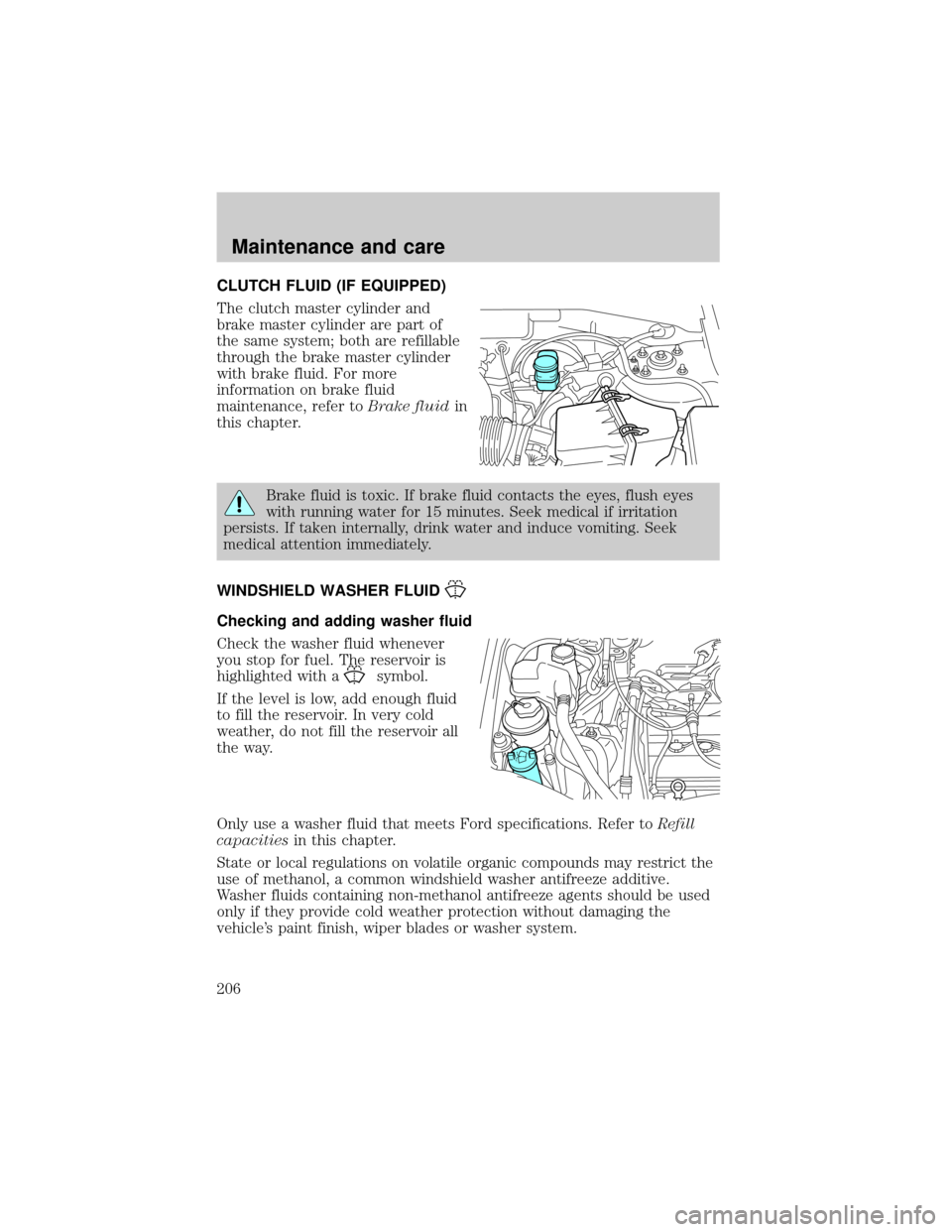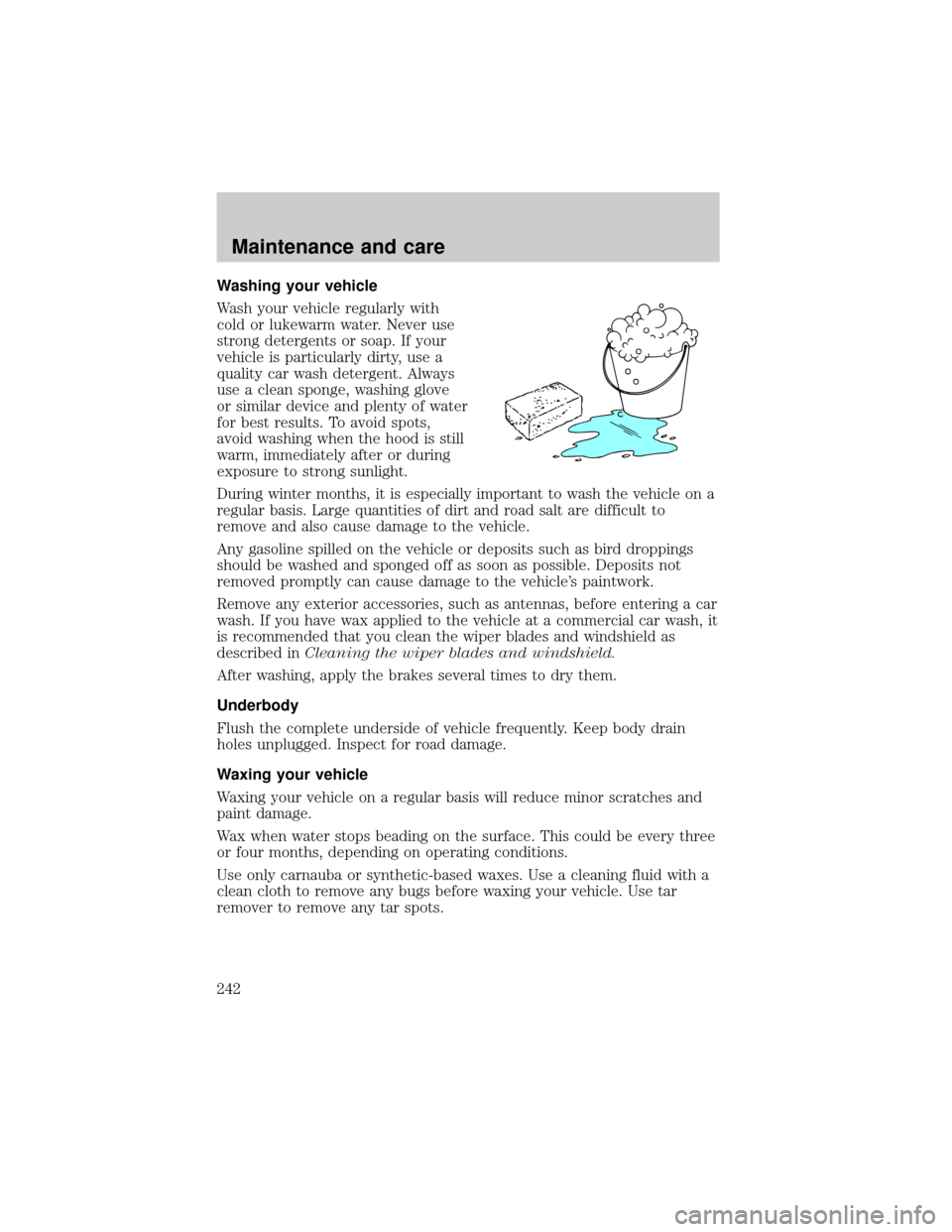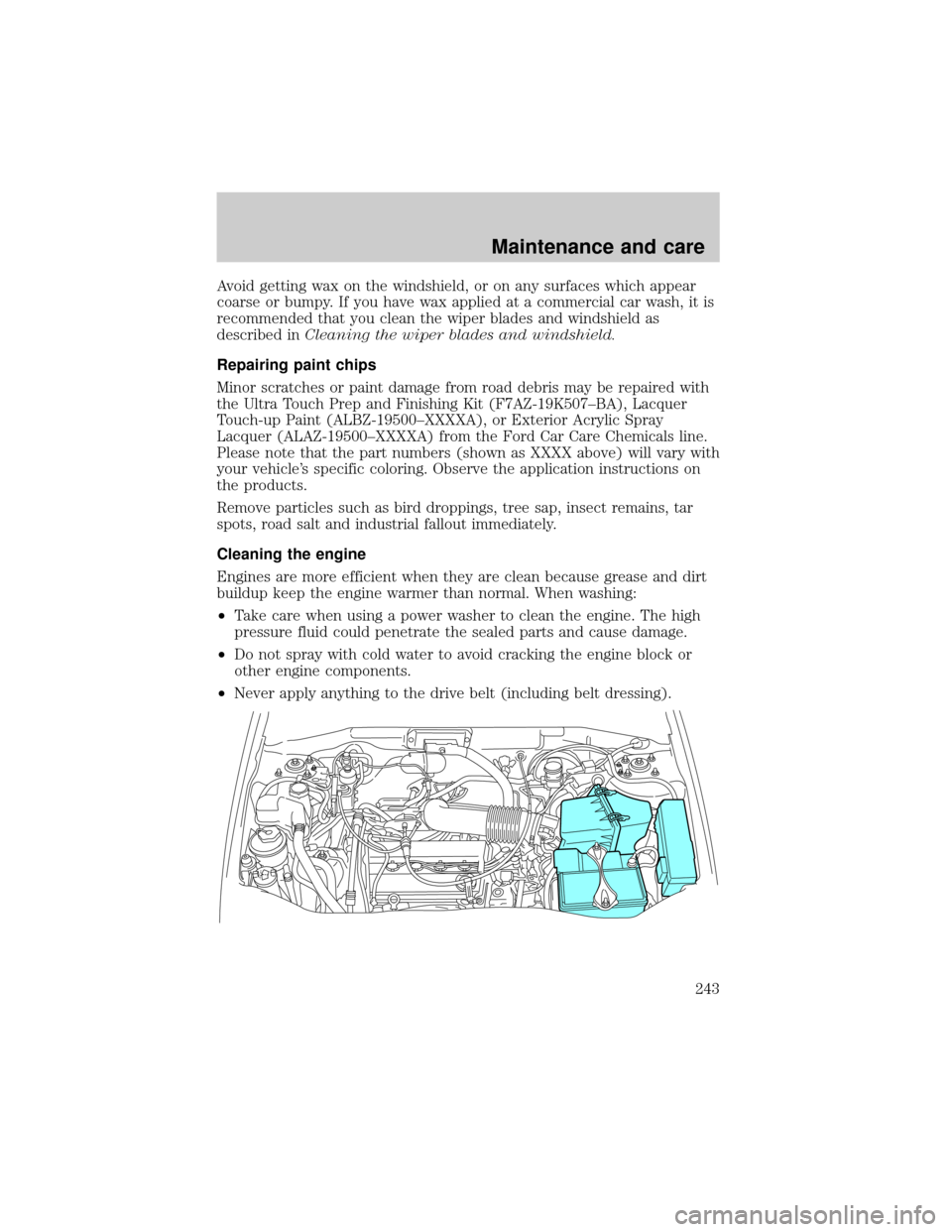2001 FORD ESCAPE wiper fluid
[x] Cancel search: wiper fluidPage 77 of 280

To activate the windshield washer,
pull control toward you. Release
control to stop washer fluid spray.
MIST FUNCTION
Move control up and release for one
wipe.
Rear window wiper/washer controls
For intermittent operation of rear
wiper, rotate end of control upward
to the INT position.
For normal speed rear wiper
operation, rotate control upward to
ON.
Controls and features
77
Page 206 of 280

CLUTCH FLUID (IF EQUIPPED)
The clutch master cylinder and
brake master cylinder are part of
the same system; both are refillable
through the brake master cylinder
with brake fluid. For more
information on brake fluid
maintenance, refer toBrake fluidin
this chapter.
Brake fluid is toxic. If brake fluid contacts the eyes, flush eyes
with running water for 15 minutes. Seek medical if irritation
persists. If taken internally, drink water and induce vomiting. Seek
medical attention immediately.
WINDSHIELD WASHER FLUID
Checking and adding washer fluid
Check the washer fluid whenever
you stop for fuel. The reservoir is
highlighted with a
symbol.
If the level is low, add enough fluid
to fill the reservoir. In very cold
weather, do not fill the reservoir all
the way.
Only use a washer fluid that meets Ford specifications. Refer toRefill
capacitiesin this chapter.
State or local regulations on volatile organic compounds may restrict the
use of methanol, a common windshield washer antifreeze additive.
Washer fluids containing non-methanol antifreeze agents should be used
only if they provide cold weather protection without damaging the
vehicle's paint finish, wiper blades or washer system.
Maintenance and care
206
Page 242 of 280

Washing your vehicle
Wash your vehicle regularly with
cold or lukewarm water. Never use
strong detergents or soap. If your
vehicle is particularly dirty, use a
quality car wash detergent. Always
use a clean sponge, washing glove
or similar device and plenty of water
for best results. To avoid spots,
avoid washing when the hood is still
warm, immediately after or during
exposure to strong sunlight.
During winter months, it is especially important to wash the vehicle on a
regular basis. Large quantities of dirt and road salt are difficult to
remove and also cause damage to the vehicle.
Any gasoline spilled on the vehicle or deposits such as bird droppings
should be washed and sponged off as soon as possible. Deposits not
removed promptly can cause damage to the vehicle's paintwork.
Remove any exterior accessories, such as antennas, before entering a car
wash. If you have wax applied to the vehicle at a commercial car wash, it
is recommended that you clean the wiper blades and windshield as
described inCleaning the wiper blades and windshield.
After washing, apply the brakes several times to dry them.
Underbody
Flush the complete underside of vehicle frequently. Keep body drain
holes unplugged. Inspect for road damage.
Waxing your vehicle
Waxing your vehicle on a regular basis will reduce minor scratches and
paint damage.
Wax when water stops beading on the surface. This could be every three
or four months, depending on operating conditions.
Use only carnauba or synthetic-based waxes. Use a cleaning fluid with a
clean cloth to remove any bugs before waxing your vehicle. Use tar
remover to remove any tar spots.
Maintenance and care
242
Page 243 of 280

Avoid getting wax on the windshield, or on any surfaces which appear
coarse or bumpy. If you have wax applied at a commercial car wash, it is
recommended that you clean the wiper blades and windshield as
described inCleaning the wiper blades and windshield.
Repairing paint chips
Minor scratches or paint damage from road debris may be repaired with
the Ultra Touch Prep and Finishing Kit (F7AZ-19K507±BA), Lacquer
Touch-up Paint (ALBZ-19500±XXXXA), or Exterior Acrylic Spray
Lacquer (ALAZ-19500±XXXXA) from the Ford Car Care Chemicals line.
Please note that the part numbers (shown as XXXX above) will vary with
your vehicle's specific coloring. Observe the application instructions on
the products.
Remove particles such as bird droppings, tree sap, insect remains, tar
spots, road salt and industrial fallout immediately.
Cleaning the engine
Engines are more efficient when they are clean because grease and dirt
buildup keep the engine warmer than normal. When washing:
²Take care when using a power washer to clean the engine. The high
pressure fluid could penetrate the sealed parts and cause damage.
²Do not spray with cold water to avoid cracking the engine block or
other engine components.
²Never apply anything to the drive belt (including belt dressing).
Maintenance and care
243
Page 271 of 280

exterior ............................242±243
exterior lamps .........................244
instrument cluster lens ..........246
instrument panel ....................245
interior .............................245±246
mirrors .....................................246
plastic parts ............................244
safety belts ..............................246
washing ....................................242
waxing .....................................242
wheels ......................................244
windows ..................................246
wiper blades ............................245
woodtone trim ........................246
Climate control (see Air
conditioning or Heating) ............21
Clock ..........................32, 41, 51, 69
Clutch
fluid ..........................................206
Console ........................................85
overhead ....................................78
Controls
power seat .................................99
Coolant
checking and adding ..............208
refill capacities ................212, 247
specifications ..................250, 252
Cruise control (see Speed
control) ........................................73
Customer Assistance ................173
Ford accessories for your
vehicle .....................................263
Ford Extended Service Plan .255
Getting assistance outside the
U.S. and Canada .....................262
Getting roadside assistance ...173
Getting the service you
need .........................................256Ordering additional owner's
literature .................................267
The Dispute Settlement
Board .......................................258
Utilizing the
Mediation/Arbitration
Program ...................................261
D
Daytime running lamps (see
Lamps) .........................................81
Defrost
rear window ..............................20
Dipstick
automatic transmission fluid .214
engine oil .................................201
Doors
door ajar warning .....................14
lubricant specifications ..........250
Driving under special
conditions ..................................154
mud ..........................................153
sand .........................................153
snow and ice ...................153±154
through water .................153, 157
E
Emergencies, roadside
jump-starting ..........................188
Emission control system ..........233
Engine ........................................252
check engine/service engine
soon light ..................................10
cleaning ...................................243
coolant .....................................208
idle speed control ...................216
Index
271
Page 275 of 280

warning light and
chime ...........................12, 15, 113
Safety seats for children ..........128
Seat belts (see Safety
restraints) ..................................107
Seats ............................................98
child safety seats ....................128
cleaning ...................................245
SecuriLock passive anti-theft
system ....................................93±94
Servicing your vehicle ..............196
Snowplowing .................................5
Spark plugs,
specifications .....................247, 252
Special notice ................................4
ambulance conversions ..............5
utility-type vehicles ....................4
Specification chart,
lubricants ...........................250, 252
Speed control ..............................73
Speedometer ...............................17
Starting your vehicle ........137, 139
jump starting ..........................188
Steering wheel
controls ......................................73
T
Tachometer .................................17
Temperature control (see
Climate control) ..........................21
Tires ...........................183, 219±221
changing ..........................183±184
checking the pressure ............221
replacing ..................................223rotating ....................................221
snow tires and chains ............223
tire grades ...............................220
treadwear ................................220
Towing .......................................157
recreational towing .................161
trailer towing ..........................157
wrecker ....................................194
Transaxle
automatic operation ...............146
fluid, checking and adding
(manual) .................................216
Transmission
fluid, checking and adding
(automatic) .............................214
fluid, refill capacities ..............247
lubricant specifications ..250, 252
Turn signal ............................12, 71
V
Vehicle dimensions ...................252
Vehicle Identification Number
(VIN) ..........................................254
Vehicle loading ..........................155
Ventilating your vehicle ...........141
W
Warning chimes ...........................15
Warning lights (see Lights) .......10
Washer fluid ..............................206
Water, Driving through .............157
Windows
power .........................................82
rear wiper/washer .....................77
Index
275
Page 276 of 280

Windshield washer fluid and
wipers
checking and adding fluid .....206
checking and cleaning ....218±219
liftgate reservoir .....................207operation ...................................76
replacing wiper blades ...........219
Wrecker towing .........................194
Index
276